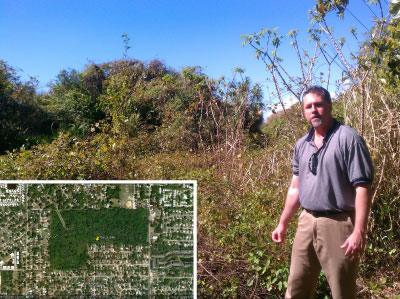“Best-kept secrets” in exclusive south Tampa tend to be upscale restaurants or sophisticated boutiques. For nature lovers, hikers and bikers, however, the MacDill 48 is a nearly unknown wilderness area in one of the region’s most densely developed neighborhoods.

The 48-acre site, located off MacDill Avenue just south of Interbay Boulevard, encompasses oak hammocks, pine flatwoods, shrub swamp and even a natural bayhead forest with an enormous magnolia tree. Surrounded by a chain-link fence except for a single entryway at the foot of Martindale Street, the park is a secret some residents would like to keep that way.
It’s a particularly special place for Forest Turbiville, section manager for regional parks and conservation services in Hillsborough County. He first saw the forested site as a kindergartner, attending the B & R Ranch. “The school backed up to what is now the preserve and I can remember playing in it in 1974, thinking ‘just how cool is this?’ Even then it was pretty much the only natural land around, and it was just an awesome place.”
Although it was not purchased until 1992, the property was a driving force behind the creation and voter-approved funding for the Hillsborough County Environmental Lands Acquisition and Protection program. “Developers came forward with plans to build hundreds of homes on the site,” he recalls. “People who lived nearby were very unhappy with the idea but there wasn’t a source of funding available to buy it and protect it from development.”
As a student at the University of South Florida in 1996, Turbiville selected MacDill 48 as the topic for his master’s thesis on the effect of fragmentation and “island biogeology” looking at changes in ecosystems when connections to other wild areas are lost.
“MacDill 48 is the perfect example of the island effect,” he says. “It’s totally surrounded by pretty intense development.”
But while the site is protected from development, it’s losing much of its value as habitat for wildlife, particularly the gopher tortoise which has very specific requirements for success (see related story opposite page.)
Invasive plants have escaped from adjacent backyards, including air potato vines that drape many of the massive live oak trees inside the preserve, a massive stand of bamboo planted at the edge of one backyard, and non-native grasses. Even native plants, like wild grapes that are a food source for birds and small mammals, can grow so rapidly that they choke out the plants gopher tortoises need to survive.
“This area probably hasn’t been burned in 50 or 60 years,” he says, pointing to an overgrowth of wild grapes. “In a truly natural setting, it would probably burn every one to three years.”
The City of Tampa, which has managed the MacDill 48 since it was purchased, is re-focusing attention on the preserve as part of an effort to connect it with the greenways trail at Gadsden Park at the foot of MacDill Avenue.
“It will still have limited access parking but we’ll be looking at ways we can make sure it retains its environmental value,” said Greg Bayor, the city’s new director of parks and recreation. Partnerships will be critical, he adds. “We’ll be working with the county to do some mechanical clearing and the state to help with very small burns, and we’re hoping to find a nearby school or environmental organization to help maintain it.”
Prescribed burns, however, are a challenge in an urban setting. “On a larger tract of land, or one near the bay, we can wait until the wind comes out of the right direction to blow the smoke away,” Turbiville said. “There’s no way to wait for the right wind here.”
Neighborhood meetings will be held before any burns are scheduled, Bayor notes, and state forestry experts will conduct them.
Trails throughout the preserve will provide an absolutely unique opportunity for residents more accustomed to trails that surround manicured ball fields. “There just isn’t anything else like this in south Tampa — and probably never will be,” Turbiville says.
[su_divider]Originally published Spring 2012